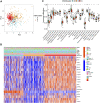m6A Methylation Patterns and Tumor Microenvironment Infiltration Characterization in Clear-Cell Renal Cell Carcinoma
- PMID: 35528542
- PMCID: PMC9068873
- DOI: 10.3389/fgene.2022.864549
m6A Methylation Patterns and Tumor Microenvironment Infiltration Characterization in Clear-Cell Renal Cell Carcinoma
Abstract
Increasing evidence suggests the essential regulation of RNA N6-methyladenosine (m6A) modification in carcinogenesis and immune response. Nevertheless, the potential impacts of these modifications on the tumor microenvironment (TME) immune cell infiltration characteristics in clear-cell renal cell carcinoma (ccRCC) remain unclear. Utilizing a consensus clustering algorithm, we determined three m6A modification patterns and identified three m6A-related gene clusters among 569 ccRCC samples, which were associated with different biological functions and clinical outcomes. Thereafter, the m6A score was constructed using m6A-associated signature genes to accurately exploit the m6A modification patterns within individual tumors. The m6A score was further demonstrated to be noticeably related to ccRCC prognosis. In addition, the m6A score was found to be strongly correlated with tumor mutational burden (TMB), microsatellite instability, immune infiltration, immune checkpoint expression, and immunotherapy response, which was also validated in the pan-cancer analyses. Our findings thoroughly elucidated that m6A modification contributes to tumor microenvironment immune-infiltrating characteristics and prognosis in ccRCC. Assessing the m6A modification patterns of individual patients with ccRCC will offer novel insights into TME infiltration and help develop more effective treatment strategies.
Keywords: N6-methyladenosine; clear-cell renal cell carcinoma; immune checkpoint inhibitors; pan-cancer; tumor microenvironment.
Copyright © 2022 Ma, Wang, Liu, Zhang, Meng and Zhang.
Conflict of interest statement
The authors declare that the research was conducted in the absence of any commercial or financial relationships that could be construed as a potential conflict of interest.
Figures








Similar articles
-
A signature based on m6A pattern and tumor microenvironment infiltration in clear cell renal cell carcinoma.Am J Transl Res. 2022 Jul 15;14(7):4931-4947. eCollection 2022. Am J Transl Res. 2022. PMID: 35958449 Free PMC article.
-
N6-Methyladenosine Modification Patterns and Tumor Microenvironment Immune Characteristics Associated With Clinical Prognosis Analysis in Stomach Adenocarcinoma.Front Cell Dev Biol. 2022 Jun 15;10:913307. doi: 10.3389/fcell.2022.913307. eCollection 2022. Front Cell Dev Biol. 2022. PMID: 35813200 Free PMC article.
-
m6A regulator-mediated methylation modification patterns and tumor microenvironment infiltration characterization in hepatocellular carcinoma.Aging (Albany NY). 2021 Aug 30;13(16):20698-20715. doi: 10.18632/aging.203456. Epub 2021 Aug 30. Aging (Albany NY). 2021. PMID: 34461607 Free PMC article.
-
The Potential Value of m6A RNA Methylation in the Development of Cancers Focus on Malignant Glioma.Front Immunol. 2022 May 30;13:917153. doi: 10.3389/fimmu.2022.917153. eCollection 2022. Front Immunol. 2022. PMID: 35711459 Free PMC article. Review.
-
Crosstalk between N6-methyladenosine (m6A) modification and noncoding RNA in tumor microenvironment.Int J Biol Sci. 2023 Apr 17;19(7):2198-2219. doi: 10.7150/ijbs.79651. eCollection 2023. Int J Biol Sci. 2023. PMID: 37151887 Free PMC article. Review.
Cited by
-
METTL14 inhibits the proliferation, migration and invasion of prostate cancer cells by increasing m6A methylation of CDK4.Transl Androl Urol. 2024 Jul 31;13(7):1145-1163. doi: 10.21037/tau-23-682. Epub 2024 Jul 16. Transl Androl Urol. 2024. PMID: 39100843 Free PMC article.
References
-
- Bedke J., Albiges L., Capitanio U., Giles R. H., Hora M., Lam T. B., et al. (2021). The 2021 Updated European Association of Urology Guidelines on Renal Cell Carcinoma: Immune Checkpoint Inhibitor-Based Combination Therapies for Treatment-Naive Metastatic clear-cell Renal Cell Carcinoma Are Standard of Care. Eur. Urol. 80, 393–397. 10.1016/j.eururo.2021.04.042 - DOI - PubMed
LinkOut - more resources
Full Text Sources

